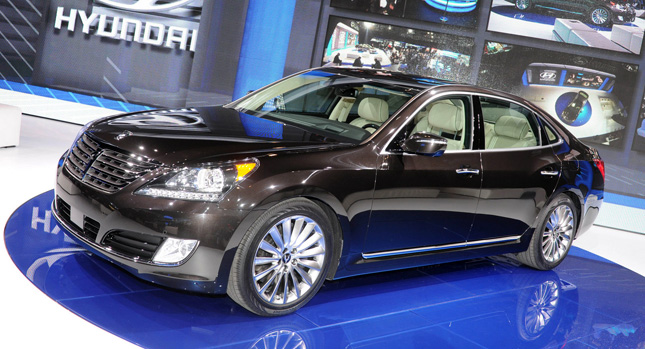Yes, you read right – the Hyundai Equus, which has just debuted in NYC in facelifted form, is the ” number-one shopped premium luxury sedan, well ahead of Mercedes-Benz S-Class (really?), BMW 7-Series, Audi A8, Lexus LS, and Jaguar XJ according to industry shopping analysis by Compete,” as stated in the Korean carmaker’s press blurb.
What that is supposed to mean, or whether it has anything to do with any aspect of reality, we don’t know. However, what Hyundai is clearly trying to say – besides the marketing nonsense, is that the Equus has been significantly improved for 2014, in several important ways.
Inside, the most notable change over the previous model is the ditching of conventional analog dials and replacing them with a 7-inch TFT cluster, which grows to 12.3 inches on the top Ultimate model. Hyundai is so quick in copying the trend set by the mainstream manufacturers, pretty much all of which now feature similar systems. Why not keep analog dials and possibly attract more classically-minded buyers, who do not want a screen instead of gauges?
Sarcasm aside, the 2014 model-year brings about a revised front fascia, new side mirrors and tail lamp graphics. Also, to compliment the refreshed styling, Hyundai is offering a new exterior finish called Night Shadow Brown – not the best choice of name, if you ask us. Inside, aside from the aforementioned digital dials, there’s also a redesigned center stack, steering wheel and controls layout, as well as a new “ivory leather interior environment.”
From the standpoint of driving dynamics and performance, the Equus should be better than before, with “revised tuning” which improves both ride comfort and sportiness, and gives the selectable driving modes (Sport, Normal and Snow) more focus – Sport mode is now stiffer, while Comfort mode is now softer than before.
Power for the Equus comes from the same impressively named Tau 5.0-liter V8, which makes 429 hp at 6,400 rpm and 376 lb-ft (509 Nm) at quite a high 5,000 rpm. It achieves a combined mpg figure of 18 on the combined cycle (23 highway/15 city), or 13 l/100 km. Hyundai is keen to point out that it is more powerful and torquey than a Lexus LS460, and the two cars are compared directly.
They also mention the fact that the car has perfect 50/50 weight distribution, and that the handling of this revised model has been improved. It also has an impressive list of safety features, and by impressive we mean long: Blind Spot Detection, Electronic Stability Control (ESC), nine airbags, electronic active front head restraints, lane departure warning system, smart cruise control and a Vehicle Stability Management (VSM) system which optimally manages the stability control system.
A high-end Lexicon audio system, three-zone climate control, self-leveling air suspension, heated and cooled front seats, improved materials and even power-reclining 60/40 split rear seats, to name but a few, make this an interesting proposal. It will never sell in huge numbers, but at least it shows that Hyundai does have the engineering know-how to build something like this, and make it better over time.
By Andrei Nedelea
PHOTO GALLERY



















































